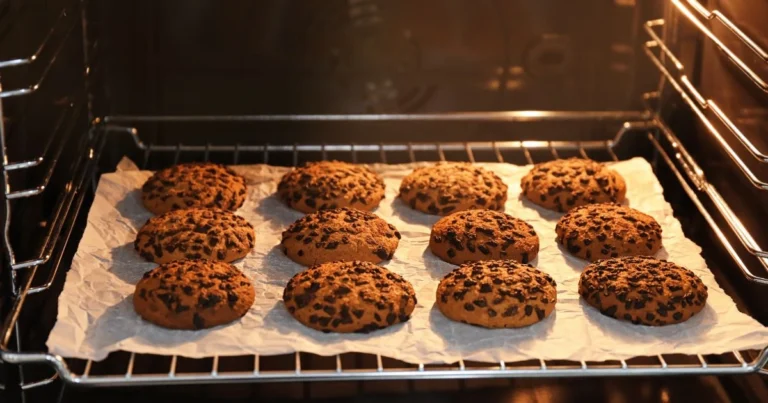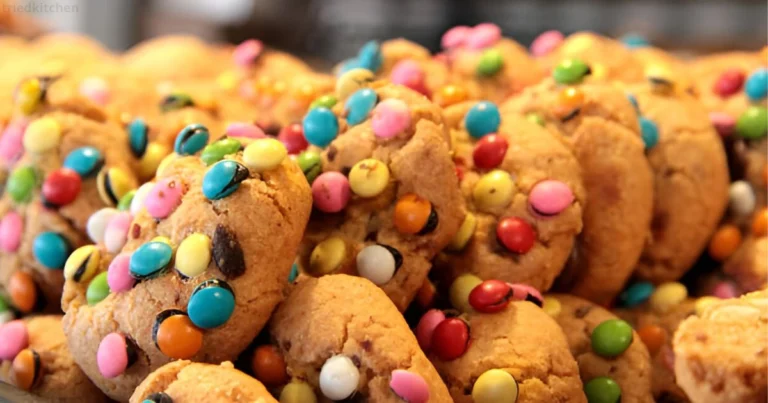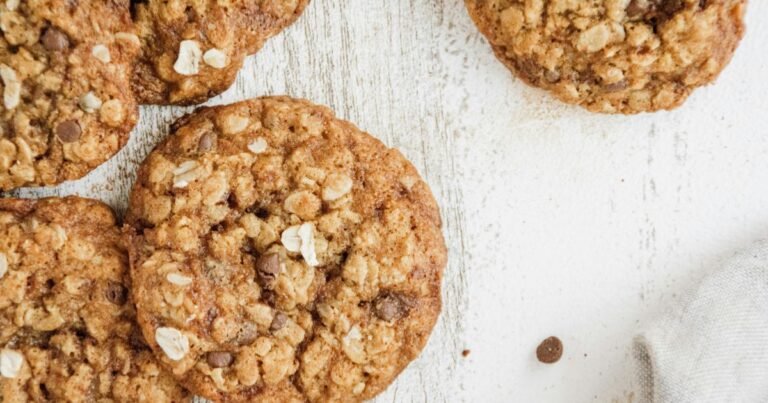Raspberry Jam Cookies vs. Classic Thumbprint Cookies: What’s the Difference?
An Emotional Opening: A Taste of Nostalgia and Comfort
Recall those vivid childhood moments, perhaps gathered around a sun-drenched kitchen counter, the irresistible aroma of baking wafting through the air, creating a sensory tapestry that endures? For countless individuals, cookies transcend a mere confection; they serve as a conduit to cherished memories, an embraceable warmth delivered in an edible form. The unpretentious thumbprint cookie, with its characteristic depression cradling a vibrant dollop of preserves, frequently conjures a sense of handcrafted excellence and simpler epochs. Yet, what transpires when the time-honored original undergoes a delightful, berry-infused transformation? Today, we embark upon a delectable exploration: does a substantive distinction exist between those beloved classic thumbprint cookies and their equally captivating relative, the raspberry jam cookies? Join us as we dissect the nuanced subtleties and surprising commonalities that render both of these treats utterly captivating.
Understanding the Core: What Defines a Thumbprint Cookie?
When you envision a cookie that speaks of tradition and comfort, the classic thumbprint cookie often springs to mind. But what precisely establishes its identity? At its heart, a classic thumbprint cookie is distinguished by its tender, often crumbly foundation, typically a shortbread-like or rich butter cookie base. This foundational dough provides the perfect canvas for the star of the show: the indentation. This signature depression, traditionally formed by a gentle press of your thumb (hence the name!), is not merely decorative; it’s a functional cradle for the sweet filling.
Historically, these delightful voids have been filled with an assortment of fruit preserves. While raspberry jam cookies are certainly a popular iteration, classic choices also include apricot, strawberry, and even grape or blackberry. Beyond fruit, you might encounter variations featuring melted chocolate, nuts, or even a dollop of caramel. The beauty of the classic thumbprint lies in its versatility. Its texture is another defining characteristic. You’ll typically find these cookies to be wonderfully crumbly, melting in your mouth with each bite, a testament to their high butter content and minimal leavening. This delicate consistency ensures the focus remains on the interplay between the buttery cookie and the vibrant filling.
Tracing their lineage, thumbprint cookies boast a rich history, with variations appearing across diverse cultures. From Swedish Hallongrotta (raspberry cave) to Jewish Hamantaschen (though structurally different, they share the filled cookie concept), the idea of a humble cookie housing a sweet surprise has resonated globally. Their enduring popularity speaks to their simplicity, adaptability, and the sheer delight they bring. When you bite into a classic thumbprint, you’re not just tasting a cookie; you’re experiencing a piece of baking heritage.
The Allure of Raspberry Jam Cookies: A Berry-Centric Delight
Now, let’s direct our attention to a specific and undeniably popular member of the thumbprint family: the raspberry jam cookies. While often falling under the broader umbrella of thumbprint cookies, these confections possess a distinct identity, primarily defined by their singular, glorious filling. The emphasis here is unequivocally on raspberry jam, transforming a general concept into a specialized indulgence.
What makes raspberry jam cookies so captivating? It begins with the vibrant color of the raspberry preserve itself. The deep, often jewel-toned red creates an immediate visual appeal, promising a burst of fruitiness even before the first bite. Beyond aesthetics, the flavor profile of raspberry jam is a critical component of its allure. The inherent tartness of raspberries provides a delightful counterbalance to the sweetness of the cookie base. This sweet-tart dynamic prevents the cookie from being overly cloying, ensuring a refreshing and more complex taste experience.
While many raspberry jam cookie recipes utilize a cookie base identical to classic thumbprints, some might exhibit subtle variations. You might encounter recipes that lean towards a slightly softer or chewier cookie dough, designed specifically to complement the vibrant and sometimes assertive flavor of raspberry. This could involve minor adjustments to the flour-to-fat ratio or the inclusion of a touch of almond extract in the dough, which harmonizes exceptionally well with raspberries.
The widespread affection for raspberry jam cookies is not coincidental. Raspberries themselves are a beloved fruit, known for their bright flavor and aromatic qualities. When concentrated into a jam, these characteristics intensify, creating a filling that is both familiar and exciting. It’s this concentrated burst of berry goodness that truly elevates a simple butter cookie into something extraordinary, making raspberry jam cookies a perennial favorite for gatherings, gifting, or simply a comforting personal treat.
Head-to-Head Comparison: Raspberry Jam Cookies vs. Classic Thumbprint Cookies
You might be pondering, “Is there truly a significant distinction, or are raspberry jam cookies simply a more specific designation for a type of thumbprint?” This is an excellent query, and the answer lies in understanding nuance.
Fundamentally, most raspberry jam cookies are a type of thumbprint cookie. The defining characteristic of a thumbprint is the indented, filled center. Therefore, any cookie with this structure, including those specifically filled with raspberry jam, fits the general definition. Think of it like this: all squares are rectangles, but not all rectangles are squares. Similarly, all raspberry jam cookies with an indentation are thumbprint cookies, but not all thumbprint cookies are raspberry jam ones.
The primary differentiator, as you’ve likely deduced, is the guaranteed presence of raspberry jam in the latter. When a recipe or description specifies “classic thumbprint cookies,” it implies a broader spectrum of permissible fillings. You could use apricot, blueberry, or even lemon curd. However, when the label is “raspberry jam cookie,” your expectation is unequivocally a vibrant, berry-filled center.
In terms of cookie dough, you’ll discover remarkable similarities. Many recipes for raspberry jam cookies employ a base virtually identical to a standard classic thumbprint recipe – a simple blend of butter, sugar, flour, and a hint of vanilla. However, there’s a subtle potential for variation. Some dedicated raspberry jam cookie recipes might subtly tweak the dough to enhance the raspberry experience. This could involve:
- Almond Flour Inclusion: A small amount of almond flour might be incorporated into the dough, providing a delicate nutty undertone that exquisitely complements the raspberry flavor.
- Almond Extract: Instead of or in addition to vanilla, a touch of almond extract in the dough can elevate the overall aromatic profile, creating a more cohesive flavor marriage with the raspberry.
- Slightly Softer Dough: In some cases, a raspberry jam cookie recipe might aim for a slightly softer dough to create a more tender chew that contrasts beautifully with the fruit filling. This is a subtle difference, but one that dedicated bakers might pursue.
Regarding baking techniques, you’ll find virtually no divergence. Both raspberry jam cookies and classic thumbprint cookies are typically baked at similar temperatures for comparable durations, with the goal of achieving a lightly golden edge and a set, yet tender, center. The filling is usually added before baking, though some recipes suggest adding it halfway through to prevent excessive bubbling or burning.
Ultimately, the distinction often comes down to specificity and preference. If you’re craving that unique tart-sweet burst of raspberry, you’ll seek out raspberry jam cookies. If you’re open to various fruit flavors or other delightful fillings, a classic thumbprint recipe offers broader possibilities. Both are delectable, and both embody the comforting essence of homemade goodness.
Recipe Showdown: Crafting Your Own Deliciousness
Now that you understand the nuances, why not try your hand at crafting these delightful confections? Here are two foundational recipes for you to explore, allowing you to appreciate the subtle differences – or similarities – firsthand.
Classic Thumbprint Cookie Recipe
This recipe yields tender, buttery cookies, perfect for any jam you desire. You’ll find these cookies to be exceptionally easy to prepare, offering a versatile base for your creative endeavors.
| Ingredient | Quantity |
| Unsalted Butter | 1 cup (2 sticks), softened |
| Granulated Sugar | ½ cup |
| All-Purpose Flour | 2 cups |
| Vanilla Extract | 1 teaspoon |
| Salt | ¼ teaspoon |
| Your Favorite Jam | ½ cup |
Instructions:
- Preparation: Preheat your oven to 350°F (175°C). Line baking sheets with parchment paper or silicone mats.
- Cream Butter and Sugar: In a large mixing bowl, using an electric mixer, cream together the softened unsalted butter and granulated sugar until light and fluffy. This step incorporates air, contributing to the cookie’s tender texture.
- Add Flavor: Beat in the vanilla extract until well combined.
- Combine Dry Ingredients: In a separate bowl, whisk together the all-purpose flour and salt.
- Combine Wet and Dry: Gradually add the dry ingredients to the wet ingredients, mixing on low speed until just combined. Be careful not to overmix, as this can lead to tough cookies. The dough should come together and be slightly crumbly but manageable.
- Form Cookies: Roll the dough into 1-inch balls. Place them about 2 inches apart on the prepared baking sheets.
- Create Indentations: Using your thumb or the back of a small measuring spoon (like a ½ teaspoon), gently press an indentation into the center of each dough ball. If the edges crack, simply smooth them out with your fingers.
- Fill with Jam: Carefully spoon about ½ teaspoon of your chosen jam into each indentation.
- Bake: Bake for 12-15 minutes, or until the edges are lightly golden and the cookies are set.
- Cool: Remove from the oven and let cool on the baking sheets for a few minutes before transferring to a wire rack to cool completely.
Raspberry Jam Cookie Recipe
This recipe is specifically tailored to highlight the exquisite flavor of raspberry jam, with an optional almond extract for a harmonious pairing. You’ll find that these raspberry jam cookies are simply irresistible.
| Ingredient | Quantity |
| Unsalted Butter | 1 cup (2 sticks), softened |
| Granulated Sugar | ½ cup |
| All-Purpose Flour | 2 cups |
| Almond Extract (optional) | ½ teaspoon |
| Salt | ¼ teaspoon |
| Raspberry Jam | ½ cup |
Instructions:
- Preparation: Preheat your oven to 350°F (175°C). Line baking sheets with parchment paper or silicone mats.
- Cream Butter and Sugar: In a large mixing bowl, using an electric mixer, cream together the softened unsalted butter and granulated sugar until light and fluffy.
- Add Flavor: Beat in the almond extract (if using) and then the vanilla extract until well combined. The almond extract truly enhances the raspberry flavor in these raspberry jam cookies.
- Combine Dry Ingredients: In a separate bowl, whisk together the all-purpose flour and salt.
- Combine Wet and Dry: Gradually add the dry ingredients to the wet ingredients, mixing on low speed until just combined. Do not overmix.
- Form Cookies: Roll the dough into 1-inch balls. Place them about 2 inches apart on the prepared baking sheets.
- Create Indentations: Using your thumb or the back of a small measuring spoon, gently press an indentation into the center of each dough ball.
- Fill with Jam: Carefully spoon about ½ teaspoon of raspberry jam into each indentation.
- Bake: Bake for 12-15 minutes, or until the edges are lightly golden and the cookies are set.
- Cool: Remove from the oven and let cool on the baking sheets for a few minutes before transferring to a wire rack to cool completely.
Beyond the Basics: Tips for Perfecting Your Jam Cookies
Crafting exceptional jam cookies, whether they are classic thumbprints or specialized raspberry jam cookies, involves more than just following a recipe. A few key techniques can elevate your baking from good to truly outstanding.
- Jam Selection is Paramount: The quality of the jam you choose directly impacts the final flavor of your cookies. For raspberry jam cookies, opt for a high-quality raspberry preserve rather than jelly. Preserves contain actual fruit pieces, offering a more authentic and textured berry experience. Consider jams with less added sugar if you prefer a less intensely sweet cookie, allowing the fruit’s natural tartness to shine. A good quality jam will also hold its shape better during baking, preventing excessive bubbling or running.
- Preventing Spillage: The Art of Filling: One common challenge is jam overflowing or bubbling out of the indentation. To circumvent this, avoid overfilling. A good rule of thumb is to fill the indentation roughly two-thirds to three-quarters full. Remember, the jam will expand slightly as it heats. If you find your jam is particularly runny, you can try refrigerating it for a short period before filling to thicken it slightly.
- The Magic of Chilling the Dough: This simple step is often overlooked but profoundly beneficial. After you’ve prepared your cookie dough and before forming the balls, chilling it for at least 30 minutes (or even an hour) makes a significant difference. Chilled dough is firmer and less prone to spreading during baking, helping your raspberry jam cookies maintain their perfect, rounded shape and well-defined indentations. It also allows the flavors to meld more effectively.
- Proper Cooling for Optimal Setting: While it’s tempting to dive right in, allowing your jam cookies to cool completely on a wire rack is crucial. This cooling period permits the jam to set properly, preventing it from being too sticky or runny when you handle the cookies. It also allows the cookie itself to firm up, contributing to that desirable tender-crumbly texture.
- Creative Variations to Elevate Your Treats: Don’t hesitate to experiment!
- Glazes: A simple lemon or almond glaze drizzled over cooled raspberry jam cookies can add an extra layer of flavor and visual appeal.
- Powdered Sugar Dusting: A delicate dusting of powdered sugar adds a touch of elegance and balances the tartness of the jam.
- Different Cookie Cutters: While the thumbprint is classic, you can use small cookie cutters (like stars or hearts) to cut out shapes from rolled-out dough, then create a small indentation in the center of each with the back of a spoon.
- Nutty Edges: Before baking, roll the formed cookie dough balls in finely chopped nuts (like pecans or almonds) for added texture and flavor.
- Optimal Storage for Freshness: To keep your raspberry jam cookies fresh and delicious, store them in an airtight container at room temperature for up to 5-7 days. If your kitchen is particularly warm, or if you’ve used a jam that tends to weep, you might consider refrigerating them, though this can sometimes alter the cookie’s texture slightly. For longer storage, unfrosted baked cookies can be frozen for up to 3 months. Thaw at room temperature and then fill with jam if desired.
By implementing these tips, you’ll not only enhance the quality of your jam cookies but also gain a deeper understanding of the baking process, ensuring consistently delightful results every time you bake.
Frequently Asked Questions About Jam Cookies
You likely have a few questions as you embark on your jam cookie baking adventure. Here are some common inquiries regarding raspberry jam cookies and their classic counterparts.
What’s the best type of jam for raspberry jam cookies?
The best type of jam for raspberry jam cookies is unequivocally a good quality raspberry preserve. Preserves, unlike jellies, contain actual pieces of fruit, which contribute to a more authentic texture and a richer, more complex raspberry flavor. When selecting your preserve, look for brands that prioritize fruit content and have a balanced sweetness, allowing the natural tartness of the raspberries to shine through. Avoid overly sugary jams that might overpower the delicate cookie base.
Can I use fresh raspberries instead of jam in thumbprint cookies?
While the thought of fresh fruit might be appealing, using fresh raspberries directly in thumbprint cookies (including raspberry jam cookies) is generally not recommended. Fresh raspberries contain a high water content. During baking, this water would release, potentially making your cookies soggy or causing the filling to spread excessively and thin out. For a consistent and successful result, it’s always best to stick with a prepared fruit jam or preserve, which has already had much of its moisture reduced through cooking.
How do I keep my thumbprint cookies from spreading?
To prevent your raspberry jam cookies (and other thumbprint cookies) from spreading excessively during baking, there are several key strategies. Firstly, ensure your butter is softened to room temperature but not melted. Overly soft or melted butter can lead to dough that spreads too much. Secondly, and critically, chill your cookie dough for at least 30 minutes (or even an hour) before forming and baking the cookies. This firms up the butter in the dough, making it more resistant to spreading in the oven. Additionally, avoid overworking the dough once the flour is added; overmixing can develop the gluten, leading to tougher cookies that are more prone to spreading.
Are raspberry jam cookies gluten-free?
Traditionally, no, raspberry jam cookies are not gluten-free as they are typically made with all-purpose flour, which contains gluten. However, for those with gluten sensitivities or celiac disease, you can certainly adapt most raspberry jam cookie recipes. The simplest and most effective way is to substitute the all-purpose flour with a high-quality, one-to-one gluten-free all-purpose flour blend. These blends are specifically formulated to mimic the properties of wheat flour and usually contain a mix of different flours (like rice flour, potato starch, tapioca starch) and gums to provide structure. Always ensure your gluten-free flour blend includes a binder like xanthan gum.
Conclusion: A Celebration of Sweetness, No Matter the Name
As you have explored, whether you lovingly refer to them as classic thumbprint cookies or, with a specific craving in mind, as raspberry jam cookies, these delightful confections undeniably hold a cherished place in our culinary landscape and our personal memories. While the “raspberry jam cookie” often implies a precise, deeply satisfying filling, the fundamental essence of a thumbprint cookie endures: a tender, buttery foundation cradling a vibrant explosion of fruit. Any subtle distinctions that exist are frequently overshadowed by the collective delight and comfort they impart.
The act of baking these cookies is, for many, a journey into nostalgia, a hands-on experience that connects you with simpler pleasures. The aroma filling your kitchen, the rhythmic process of forming each small dough ball, and the anticipation as they bake – these are all integral parts of the joy.
So, we heartily encourage you: gather your ingredients, follow these guidelines, and embark on your own baking adventure. Craft a batch, savor the intricate balance of sweetness and tartness, and allow these charming treats to facilitate new memories, one exquisitely delicious bite at a time. After all, isn’t that the true heart of baking – to create, to share, and to experience pure, unadulterated enjoyment?







